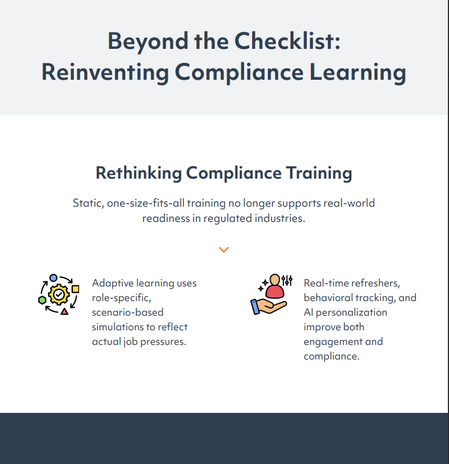From Planning to Implementation: How to Launch Adaptive Compliance Training

From Planning to Implementation: How to Launch Adaptive Compliance Training
Launching an adaptive compliance training program requires more than just new technology—it demands thoughtful planning, cross-functional collaboration, and ongoing iteration. Organizations that invest in adaptive learning platforms can reduce risk, stay audit-ready, and enable their workforce to respond confidently to regulatory change.
Don't miss our infographic, Beyond the Checklist: How Regulated Industries Are Reinventing Learning to further for a data-driven look at how adaptive compliance training is reshaping learning in regulated industries.
Step 1: Define Compliance Goals, KPIs, and Audit Requirements
Begin with clarity. Set measurable goals—such as reducing audit findings, improving retention, or accelerating time to competency. Define KPIs beyond completions: scenario scores, refresher engagement, and real-time compliance behaviors.
Understanding audit expectations early shapes system features, ensuring readiness to demonstrate learner competence and applied knowledge.
Step 2: Build a Cross-Functional Team
Adaptive compliance training spans compliance, L&D, IT, HR, and legal. Assemble a team that represents these functions to balance regulatory rigor with user experience, scalability, and data security. Strong collaboration supports smoother rollouts and sustained adoption.
Step 3: Choose a Platform Built for Modularity, AI, and Privacy
Select a system that supports:
- AI-driven personalization
- Modular content updates
- Automated audit logs
- Secure data handling
Vendor evaluations, pilot programs, and reference checks ensure alignment with organizational needs and culture.
Step 4: Audit Content and Identify Training Gaps
Analyze existing content to pinpoint outdated materials, redundant topics, or areas needing localized adaptation. Target role- and region-specific gaps to improve training relevance while reducing unnecessary seat time.
Step 5: Design Microlearning and Pilot Test
Create modular, scenario-based learning units tailored to real job contexts. Piloting with select learner groups surfaces usability issues and content gaps. Use this feedback to refine before full-scale launch.
Step 6: Integrate Systems for Seamless Deployment
Integrate with HRIS, LMS, and GRC systems to streamline user access, automate data flow, and track compliance in real time. Embedding learning in the flow of work ensures relevance and continuous engagement.
Step 7: Use Feedback and Data to Iterate
Adaptive learning is an ongoing process. Gather feedback from learners, auditors, and compliance teams to identify trends, skill gaps, and emerging risks. Use data analytics to refine content and delivery strategies.
Step 8: Automate Audit Logs and Reporting
Modern platforms enable automatic generation of:
- Learner progress logs
- Scenario performance data
- Refresher tracking
- Real-time compliance metrics
This ensures audit readiness while reducing manual administrative tasks.
Step 9: Deploy at Scale and Refresh Continuously
With systems and processes in place, scale across business units and geographies. Use modular swaps and AI-driven nudges to keep content current and aligned with changing regulations.
How Unboxed Helps
Unboxed delivers end-to-end support for launching adaptive compliance training—from strategy to scalable delivery.
- Our Skill Building Platform enables AI-driven learning journeys, modular content updates, and automated compliance tracking.
- We support scenario-based simulations tailored to job roles and regulatory contexts.
- With built-in privacy controls and seamless integrations, we help organizations stay compliant, audit-ready, and ahead of change.
Whether you're in life sciences, manufacturing, or finance, Unboxed helps you transform compliance from a burden into a strategic advantage.


